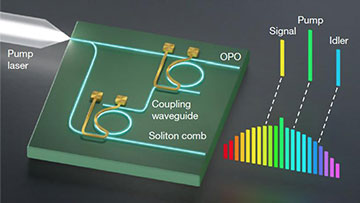
A high-level schematic of the photonic integrated chip, developed by the Gaeta lab, for all-optical optical frequency division―a method of converting a high-frequency signal to a lower frequency. [Image: Yun Zhao/Columbia Engineering]
Optical frequency division (OFD) that leverages optical references and optical frequency combs, developed a decade ago at the National Institute of Standards and Technology (NIST), USA, is used to generate the most stable microwave signals to date. The approach typically requires multiple fast-tunable laser sources and stabilization stages, and as a result, systems have high complexity and a large footprint.
Now, researchers from Columbia University, USA, say they have implemented OFD with a single laser on a photonic chip that fits on a sharp pencil point (Nature, doi: 10.1038/s41586-024-07136-2). The device reportedly generates a 16-GHz microwave signal with the lowest frequency noise that has ever been achieved in an integrated chip.
Miniaturizing OFD
Stable microwave sources are necessary components for a wide range of electronic devices, serving as clocks and information carriers. Boosting the performance of these devices, particularly for advanced applications such as metrology and high-speed data communications, requires a further reduction in phase noise.
OFD has revolutionized the field of ultralow-noise microwave generation and forms the basis of today’s atomic clocks. Essentially, two laser frequencies with a spacing in the terahertz regime are each locked to two of the nearest frequencies of an optical frequency comb. Then, the resulting frequency spacing of the two lasers is effectively “divided” by the comb. In addition, the noise of the terahertz beat frequency is also divided, resulting in a microwave signal that can be extremely low noise.
Study author Alexander Gaeta and his colleagues aimed to miniaturize OFD technology and make high-quality microwave sources available in a much more compact form factor. “Ultralow-noise microwave sources are critical for wireless communication and radar sensing. Current systems are relatively large and not portable,” said Gaeta. “Our device offers the potential to be integrated into a small, robust and highly portable package.”
A simplified design
Due to the quantum correlations of the OPO, the noise of this frequency difference can be thousands of times less than the noise of the pump laser.
Their device performs OFD entirely on a chip, in an area as small as 1 mm2, using only a single continuous-wave laser that pumps two photonically coupled, silicon nitride microresonators. One microresonator creates an optical parametric oscillator (OPO) that generates two new frequencies whose frequency spacing is set to the terahertz regime. Due to the quantum correlations of the OPO, the noise of this frequency difference can be thousands of times less than the noise of the pump laser.
The second microresonator is adjusted to generate an optical frequency comb with a mode spacing in the microwave X to W band. A small amount of light from the OPO couples to the comb generator, which leads to the locking of the microwave comb frequency to the terahertz oscillator that automatically results in optical frequency division.
Gaeta and his colleagues, including Columbia engineering professor Michal Lipson’s group, report having achieved OFD without the need of electronics, greatly simplifying the device. He believes that the technology will lead to new designs of future telecommunications devices, as well as improvements in the precision of microwave radars used for autonomous vehicles.
“The low-noise optical parametric oscillator can be realized with even lower noise by using novel material designs. The current device is limited by microkelvin level of temperature fluctuations in the silicon nitride,” said Gaeta. “[We hope to employ] novel photonic-chip materials such that the net refractive index change can be made to zero, thus fully suppressing the effect of temperature fluctuations.”
